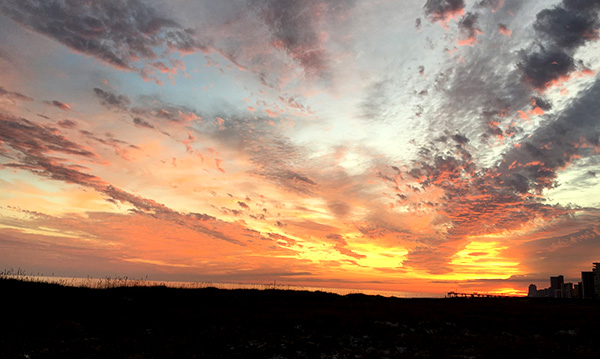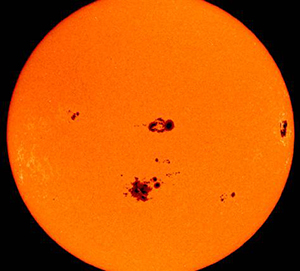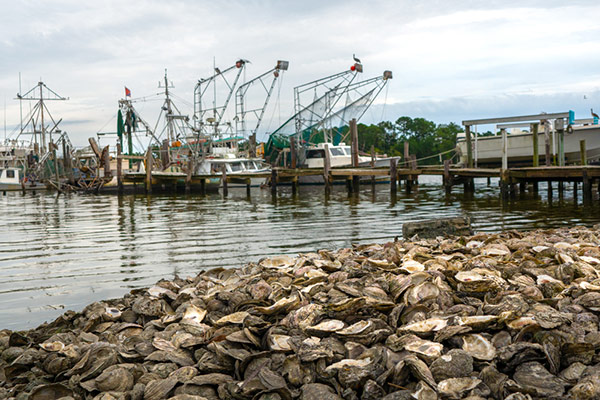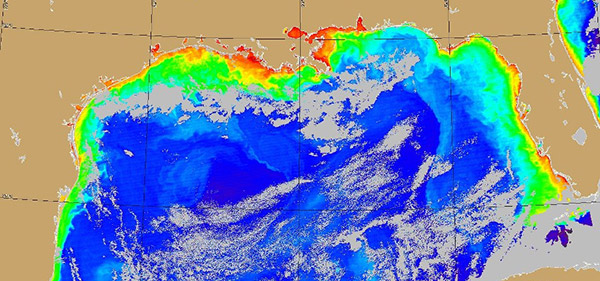HAB Research and Technology Trends
(Updated October 2021)
Top Picks From The 10th U.S. HAB Symposium
Sometimes it’s hard to believe my good fortune, like getting to attend great conferences as part of my day job. Not only was the 10th U.S. HAB Symposium in gorgeous Orange Beach, Alabama, where “sugar-white sands,” 70⁰F and beautiful sunsets framed my evening strolls, but also it offered presentations by some of the best harmful algal bloom (HAB) researchers in the world, talks and posters by students who will be tomorrow’s leaders, and new insights into public awareness and policy.

What’s the Latest in HAB Research and Technology?
The conference abstracts (PDF) reveal both incremental and significant advances in our understanding of nutrient pollution, climate change, and microbial communities that all influence bloom dynamics and impacts, and which were the dominant topics of the conference.
Some of the most exciting technological advances were rooted in classical technologies, such as the HABScope built for the Gulf of Mexico Coastal Ocean Observing System (GCOOS). The HABScope combines a very basic microscope with software and telemetry so that a citizen scientist with minimal training can transmit on-the-spot cell counts of the red-tide former Karenia brevis. It was also exciting to see how technologies like MBARI’s Environmental Sample Processor have evolved into an AUV-deployable form factor, opening up the potential for full commercialization and expansion of the on-board assays and sensors.
But three presentations or trends really excited me, and are discussed below. Be aware that the conference had two concurrent tracks, and so my “sampling” was limited to less than 50% of all the great talks delivered, plus all the posters. With that in mind, here are my top three picks from the Symposium. (Learn more, Answers to the Top 5 HAB Monitoring Questions).
1) Observed Correlation Between Sunspot Numbers and Intense Blooms of Karenia SP. on the West Florida Shelf
(Kirkpatrick et al., Mote Marine Laboratory).

Every so often, you hear a talk that is so distinct from all the others that you might never forget it, even if for no other reason than causing you to ask “why the heck hasn’t anyone thought of this before?” Dr. Gary Kirkpatrick’s talk about sunspots was such an event for me.
Mote Marine Laboratory is on the Western coast of Florida and is heavily engaged in monitoring, assessing, and studying the Florida Red Tide, attributed to the dinoflagellage Karenia brevis. There is no shortage of papers about the nutrient pollution and environmental factors that both contribute and respond to the Red Tide, nor about its impacts, including our recent article in Mission: Water magazine, Red Tide Monitoring in the Gulf of Mexico | From Cells to Satellites. But Kirkpartick’s talk took us to a different time and space, almost literally!
Sunspot records date as far back as the 17th century and qualitative assessments of red tides can be traced to as early as the mid-19th century. Evaluating them together revealed that there is a lag-style response of red tides to the solar cycle, with recorded blooms following the peak periods of solar radiation (low sunspot counts) by about two months. As Kirkpatrick pointed out, this does not discount the influence of other environmental conditions upon red tides, nor would red tides be unique in this response since many biological cycles are shown to be influenced by the solar cycles. So while this audience member thought this was waaaaaaay cool, upon reflection it really should come as no surprise that this correlation exists. What did come as a surprise was the diligent collection and analysis of the historical data that enabled the Mote team to demonstrate this principle. I can’t recall ever seeing data from the 17th century cited at a biology-flavored conference.
But beyond the immensely high coolness factor, why does this matter? One reason is that today’s Florida Red Tide watchers are taking advantage of tools like NOAA’s Gulf of Mexico Harmful Algal Bloom Forecast. This sophisticated and ever-improving forecast incorporates cell count data, satellite-visualized pigment intensities, and current data to present a snapshot of Karenia brevis growth as well as a 3-4 day forecast for a bloom.
Should the solar cycle also be considered in these forecasts, or could the solar cycle influence longer-term forecasts? Such thought-provoking outcomes are exactly why a talk like this one matters.
2) HAB Stakeholder and Community Meeting
(Hosted by the University of South Alabama’s Dauphin Island Sea Lab (DISL) and the Mississippi-Alabama Sea Grant Consortium (MASGC), moderated by Drs. Alison Robertson (DISL) and Melissa Partyka (MASGC).
Part of what made this session so enjoyable was how well it was moderated. I have been to dozens of conferences including several with “roundtable discussions” or “stakeholder meetings,” well-intended events to get broader input and understanding on a topic, but which often devolve into specific individuals dominating the conversation to promote the importance of their own research or awkward encounters where scientists try to explain their research to “real people” and it becomes apparent that some scientists have never actually talked to people that are affected by their research, but who are not themselves scientists.
No such communication conundrums would arise on Robertson and Paryka’s watch, as these women skillfully managed the conversation so that it would yield meaningful outcomes and indeed, some enlightenment for the entire audience. The save of the night was certainly when Robertson thwarted a quickly-escaping-to-Inappropriate Land Vaseline reference by one panelist, who ended up providing some of the most useful advice of the night.
As a solid Midwesterner, I have had a notional awareness of the effects of HABs on oyster growers, and as a biologist, I have been aware of the concentration of algal toxins in the tissues of bivalves and the risks of paralytic shellfish poisoning (PSP) associated with consuming affected oysters. Two of the stakeholders in attendance, including one of the panelists, are oyster farmers in Alabama and gave me a whole new understanding of their pain (which is the reason for stakeholder engagement).
From them I learned that with a lack of risk-based information to cite, many Gulf coast states shut down smaller farmers’ operations in the interests of protecting the health of consumers when faced with red tides. For example, a Florida Red Tide in November 2015 shut down Alabama’s oyster harvest completely, with harsh economic consequences not only for these farmers but also for their communities at large.
One suggestion that I wholeheartedly support is to work towards something like the FDA’s “risk calculator” (download) designed to address Vibrio cholerae contamination of oysters in the early 2000s. This approach is something the HAB research field could certainly strive towards, and I would further propose that NOAA is the right organization to take the lead. Of course, the argument has always been that we don’t have enough data to do this. I’m not sure I’d agree, and that’s part of the point. As years go on and more information becomes available, the risks are revised and improved.

3) Freshwater Comes to the Fore
Maybe 10-15 years ago, we freshwater folk would lament that the funding and interest in marine HABs always dwarfed interest in freshwater cyanobacterial HABs. There was a good reason for that. Cyanobacterial HABs in lakes and reservoirs were not as common, not as big, and at that time not thought to be as much of a threat to human health. Further, a lot of the research was funded by NOAA, so beyond the Great Lakes, there wasn’t much interest for many years in HABs that affected inland lakes.
My, how times have changed! While people in the field know that freshwater HABs have long been an issue, it is generally agreed that this shift was ushered in via the Do Not Drink order in the City of Toledo, OH in August 2014. In the wake of that event the State of Ohio led the way in providing guidelines and setting up a comprehensive testing program, well ahead of the USEPA issuing guidance on toxin levels in finished drinking water. (Learn more, Water Quality | Who's Minding the Planet | YSI).
This focus on freshwater brings with it a change in research priorities. This is not only due to the biology and ecosystems being different; there is also a change in the stakeholders. The shellfish industry and coastal tourism communities have different viewpoints and needs than the drinking water managers and inland lake communities dealing with cyanobacterial HABs in their reservoirs, lakes, and even rivers.
For example, early detection with in situ sensors is a higher value proposition for inland drinking water reservoir managers, because they want to rapidly adapt their water intakes and treatment processes to deal with both the biomass and the toxins. Their need is for high-resolution, highly localized detection.
By contrast, satellite-based detection and forecasting is of more value to the coastal communities since they can combine that with ocean current data to give reasonable forecasts and because the size of the system (e.g. the Gulf of Mexico) lends it well to that more global overview.
Whether you’re an inland or coastal stakeholder, something that I’m sad to say hasn’t changed much in the past 15 years is the ongoing need for inexpensive, fast, and reliable tests for algal toxins. I believe that one reason for that is that there is not a good economic incentive for commercial partners to be engaged in the development of testing technologies. Perhaps that will change as, sadly, HABs continue to grow as a global concern, and the need for HAB and toxin detection will become more necessary.

NOAA Harmful Algal Bloom Forecast
(View Sourcewater Algae Infographic)

Additional Blog Posts of Interest